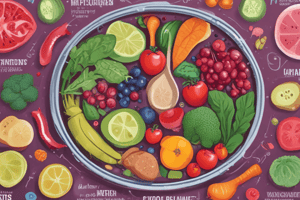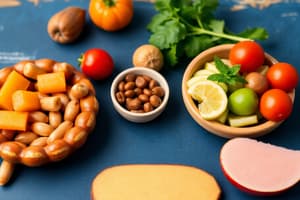Podcast
Questions and Answers
How many nutrients are essential to human life?
How many nutrients are essential to human life?
45
Which of the following are examples of non-essential nutrients?
Which of the following are examples of non-essential nutrients?
- Carbohydrates
- Antioxidants (correct)
- Phytochemicals (correct)
- Proteins
What are the six main classes of nutrients?
What are the six main classes of nutrients?
- Carbohydrates, fats, proteins, vitamins, minerals
- Proteins, fats, carbohydrates, water, vitamins, minerals
- Carbohydrates, fats, proteins, water, vitamins, minerals (correct)
- Proteins, fats, carbohydrates, fiber, vitamins, minerals
What are the energy-yielding nutrients?
What are the energy-yielding nutrients?
Which of the following factors influences energy needs in humans?
Which of the following factors influences energy needs in humans?
Energy needs increase with age and peak at 18-25 years.
Energy needs increase with age and peak at 18-25 years.
Males typically have a lower energy need than females.
Males typically have a lower energy need than females.
What is the formula for calculating Total Energy Expenditure (TEE)?
What is the formula for calculating Total Energy Expenditure (TEE)?
What does BMR stand for?
What does BMR stand for?
What are the Harris-Benedict equations used to estimate?
What are the Harris-Benedict equations used to estimate?
What is the PAL for someone who is chair or bed bound?
What is the PAL for someone who is chair or bed bound?
What is the PAL for someone engaged in strenuous work or high leisure activities?
What is the PAL for someone engaged in strenuous work or high leisure activities?
Michael Phelps, a renowned swimmer, is known for consuming a diet of 12,000 calories per day.
Michael Phelps, a renowned swimmer, is known for consuming a diet of 12,000 calories per day.
What is the primary function of dietary carbohydrates?
What is the primary function of dietary carbohydrates?
What are the two types of dietary carbohydrates?
What are the two types of dietary carbohydrates?
Which of the following are examples of monosaccharides?
Which of the following are examples of monosaccharides?
Which of the following is a polysaccharide?
Which of the following is a polysaccharide?
What is glycogen?
What is glycogen?
Starch is a storage form of glucose found in grains, tubers, and legumes.
Starch is a storage form of glucose found in grains, tubers, and legumes.
What is considered 'white flour'?
What is considered 'white flour'?
Whole grains are less nutritious than refined grains.
Whole grains are less nutritious than refined grains.
Dietary fiber is a form of starch.
Dietary fiber is a form of starch.
What are the two main types of dietary fiber?
What are the two main types of dietary fiber?
Which of the following is an example of soluble fiber?
Which of the following is an example of soluble fiber?
Insoluble fiber is viscous and fermentable.
Insoluble fiber is viscous and fermentable.
Functional fibers are naturally occurring fibers found in foods.
Functional fibers are naturally occurring fibers found in foods.
Glycemic index is a tool used to classify fats.
Glycemic index is a tool used to classify fats.
The glycemic index assesses the impact of a standard amount of 50 grams of a carbohydrate food on blood glucose responses.
The glycemic index assesses the impact of a standard amount of 50 grams of a carbohydrate food on blood glucose responses.
Glycemic index is a useful tool for people with diabetes.
Glycemic index is a useful tool for people with diabetes.
Which of the following are sources of free sugars?
Which of the following are sources of free sugars?
Health Canada recommends a maximum intake of 100 grams of total sugars per day.
Health Canada recommends a maximum intake of 100 grams of total sugars per day.
The World Health Organization recommends that free sugars should constitute less than 10% of total daily calories.
The World Health Organization recommends that free sugars should constitute less than 10% of total daily calories.
The World Health Organization recommends that added sugars should constitute less than 5% of total daily calories.
The World Health Organization recommends that added sugars should constitute less than 5% of total daily calories.
A 2000-kcal diet allows for a maximum of 50 grams of free sugar per day.
A 2000-kcal diet allows for a maximum of 50 grams of free sugar per day.
The statement 'no added sugar' guarantees a product is free of sugar.
The statement 'no added sugar' guarantees a product is free of sugar.
One 200-mL juice box provides approximately the same amount of calories as two small oranges.
One 200-mL juice box provides approximately the same amount of calories as two small oranges.
Water and white milk contain added sugars.
Water and white milk contain added sugars.
What is the primary form of dietary fat?
What is the primary form of dietary fat?
Dietary fat provides 4 kcal per gram.
Dietary fat provides 4 kcal per gram.
Fats are stored in the body as triglycerides.
Fats are stored in the body as triglycerides.
Saturated fats are considered to be healthier than unsaturated fats.
Saturated fats are considered to be healthier than unsaturated fats.
Which of the following is an example of a monounsaturated fat?
Which of the following is an example of a monounsaturated fat?
Essential fatty acids can be synthesized by the body.
Essential fatty acids can be synthesized by the body.
Linoleic acid is an omega-3 fatty acid.
Linoleic acid is an omega-3 fatty acid.
Alpha-linolenic acid is an omega-3 fatty acid.
Alpha-linolenic acid is an omega-3 fatty acid.
A diet high in omega-6 fatty acids is associated with a higher risk of certain chronic diseases.
A diet high in omega-6 fatty acids is associated with a higher risk of certain chronic diseases.
Which of the following are examples of omega-3 fatty acids?
Which of the following are examples of omega-3 fatty acids?
Omega-3 fatty acids are beneficial for brain health.
Omega-3 fatty acids are beneficial for brain health.
DHA and EPA can be synthesized from ALA.
DHA and EPA can be synthesized from ALA.
Trans fatty acids are naturally occurring in foods like meat and milk.
Trans fatty acids are naturally occurring in foods like meat and milk.
Artificial trans fats are considered to be healthier than naturally occurring trans fats.
Artificial trans fats are considered to be healthier than naturally occurring trans fats.
Trans fats are often used in baked goods, packaged foods, and fried foods.
Trans fats are often used in baked goods, packaged foods, and fried foods.
Trans fats can increase the risk of heart disease.
Trans fats can increase the risk of heart disease.
Artificial trans fats were banned in Canada in 2015.
Artificial trans fats were banned in Canada in 2015.
Flashcards
Six classes of nutrients
Six classes of nutrients
The six main classes of nutrients essential for human life, which must be obtained from the diet.
Macronutrients
Macronutrients
Nutrients that provide energy to the body, including carbohydrates, proteins, and fats.
Basal Metabolic Rate (BMR)
Basal Metabolic Rate (BMR)
The amount of energy needed to maintain basic bodily functions at rest, including breathing, heartbeat, and organ function.
Total Energy Expenditure (TEE)
Total Energy Expenditure (TEE)
Signup and view all the flashcards
Physical Activity Level (PAL)
Physical Activity Level (PAL)
Signup and view all the flashcards
Harris-Benedict Equations
Harris-Benedict Equations
Signup and view all the flashcards
Glycogen
Glycogen
Signup and view all the flashcards
Dietary Fiber
Dietary Fiber
Signup and view all the flashcards
Soluble Fiber
Soluble Fiber
Signup and view all the flashcards
Insoluble Fiber
Insoluble Fiber
Signup and view all the flashcards
Functional Fibers
Functional Fibers
Signup and view all the flashcards
Glycemic Index (GI)
Glycemic Index (GI)
Signup and view all the flashcards
Glycemic Load (GL)
Glycemic Load (GL)
Signup and view all the flashcards
Simple Carbohydrates
Simple Carbohydrates
Signup and view all the flashcards
Complex Carbohydrates
Complex Carbohydrates
Signup and view all the flashcards
Bran
Bran
Signup and view all the flashcards
Endosperm
Endosperm
Signup and view all the flashcards
Germ
Germ
Signup and view all the flashcards
Grain Refinement
Grain Refinement
Signup and view all the flashcards
Natural Sugars
Natural Sugars
Signup and view all the flashcards
Added Sugars
Added Sugars
Signup and view all the flashcards
Unsaturated Fat
Unsaturated Fat
Signup and view all the flashcards
Saturated Fat
Saturated Fat
Signup and view all the flashcards
Trans Fats
Trans Fats
Signup and view all the flashcards
Hydrogenation
Hydrogenation
Signup and view all the flashcards
Phytochemicals
Phytochemicals
Signup and view all the flashcards
Antioxidants
Antioxidants
Signup and view all the flashcards
Nutrition
Nutrition
Signup and view all the flashcards
Digestion
Digestion
Signup and view all the flashcards
Nutritional Balance
Nutritional Balance
Signup and view all the flashcards
Malnutrition
Malnutrition
Signup and view all the flashcards
Study Notes
KINE 1020 - Introduction to Nutrition - 1
- Course date: October 7, 2024
- Instructor: Dr. A. Josse
Lifetime Food Intake
- Individuals consume a substantial amount of food throughout their lives, exceeding the weight of an elephant.
- Approximate lifetime consumption:
- Fat: 2300 kg (21 kcal* million)
- Carbohydrate (CHO): 8000 kg (31 kcal* million)
- Protein: 1900 kg (7 kcal* million)
- Water: 45,300 kg
Food Provides Nutrients
- 45 nutrients are essential for human life and obtained through diet.
- Other nutrients, like phytochemicals and antioxidants, are not essential.
- 6 main classes of nutrients exist: carbohydrates, fat, proteins, water, vitamins, and minerals.
Macronutrients
- Macronutrients are energy-yielding nutrients. This includes proteins, carbohydrates, fats.
- Other categories include water and alcohol.
Energy Needs in Humans
- Energy requirements vary based on factors like body weight, height, age, and sex.
- Energy needs peak in the late teens to early twenties.
- Males generally require more energy than females due to greater lean body mass.
- Pregnancy and breastfeeding increase energy needs.
- Pregnancy in the second and third trimester increases energy needs by approximately 250 kcal per day.
- Breastfeeding can increase energy needs by 550-650 kcal.
Calculating Energy Needs
- Total energy expenditure (TEE) is calculated by multiplying basal metabolic rate (BMR) by physical activity level (PAL).
- BMR can be determined using the Harris-Benedict equations (from 1919) which takes into account age, height and weight.
- PAL values are based on activity level (chair/bedbound - 1.2, standing work - 1.8-1.9).
Dietary Carbohydrates
- Carbohydrates provide 4 kcal/gram of energy.
- Simple carbohydrates include monosaccharides (glucose, fructose, galactose) and disaccharides (maltose, sucrose, lactose).
- Complex carbohydrates include polysaccharides like glycogen and starch, which are stored forms of glucose in muscle and found in grains, tubers, and legumes.
- Endosperm is the part of the grain containing primarily starch and is more refined than other parts of the grain (bran and germ).
- Whole grains contain endosperm, germ, and bran, offering better nutritional value.
Dietary Fibre
- Dietary fiber is a non-starch polysaccharide/complex carbohydrate.
- Soluble fiber forms gels, ferments, lowers blood glucose, decreases cholesterol, and feeds gut bacteria. (example: psyllium, beta-glucan, apples, legumes).
- Insoluble fiber bulks up stool, promotes regularity, relieves constipation, and may prevent colon cancer (example: wheat bran, cellulose).
- Functional fibers are added to foods.
Glycemic Index (GI)
- A carbohydrate classification tool that assesses how different carbohydrates affect blood glucose levels compared to a reference food (50g glucose/white bread).
- Useful in managing blood sugar levels in individuals with diabetes.
Sugars
- Health Canada and international health organizations suggest limiting total sugar intake.
- Free sugars are those not naturally present in fruits, vegetables, or milk.
- They recommend that free sugars be less than 10% of total energy intake per day. Also added sugars should be less than 5%.
- Free Sugars - usually an average maximum of ~50g per day.
- Sugar is found in many foods and drinks: sugar sweetened beverages, baked goods and sweets.
- Note that even products labeled as 'no added sugars' can still contain significant amounts of natural sugars.
Dietary Fat
- Fats provide 9 kcal/gram of energy.
- Fatty acids (saturated, monounsaturated, polyunsaturated) are the basic forms of fat.
- Fats are stored as triglycerides in the body.
- Different types of fatty acids have different health implications.
Essential Fatty Acids – PUFA
- Essential fatty acids (EFAs) are polyunsaturated fatty acids (PUFAs) that need to be consumed in the diet as our bodies cannot synthesize them.
- Linoleic acid (omega-6) and alpha-linolenic acid (omega-3) are essential fatty acids.
- Important to maintain a balance between omega-6 and omega-3 fatty acids in the diet.
Essential Fatty Acids – Omega 3
- Docosahexaenoic acid (DHA) and eicosapentaenoic acid (EPA) are essential omega-3 fatty acids.
- These omega-3 fatty acids are found in fish oils, salmon, trout, and seafood.
- Health benefits include lowering blood clots, inflammation, and blood pressure, and benefit brain health.
Trans Fatty Acids
- Trans fats are unsaturated fats.
- They are naturally found in smaller quantities in animal products, but partially hydrogenated oils are a common source.
- Trans-fat is associated with increased risks of heart disease.
- Many countries have banned or restricted the use of artificial trans fats in food.
Studying That Suits You
Use AI to generate personalized quizzes and flashcards to suit your learning preferences.




